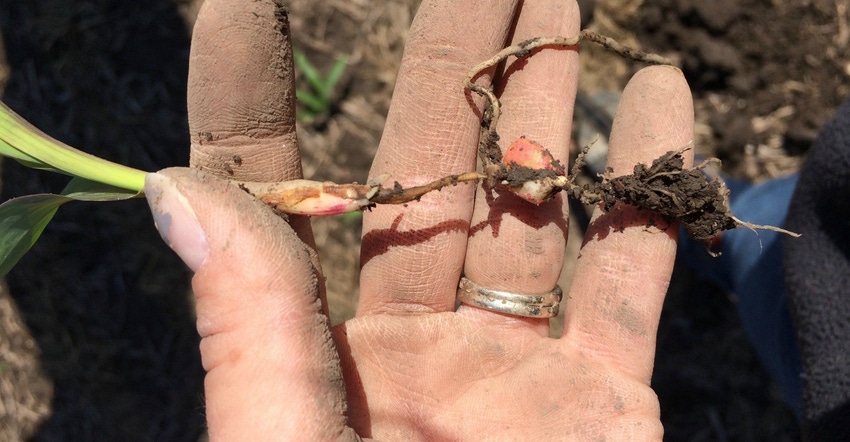May 6, 2019

During the last two weeks, planters made progress across portions of Iowa. However, rain in many areas of the state the last weekend in April and the first five days of May slowed things down. More planters were parked in the shed instead of rolling across fields. With the cool, wet weather, soil temperatures quickly fell below 50 degrees F. What does this mean for corn and soybeans that were already planted?
In wet and cool conditions, the germinating seed can run into problems with imbibitional chilling, says Mark Licht, Iowa State University Extension agronomist. Imbibition is the process of the seed in the soil taking up water. Chilling occurs when there is a drastic change in the water temperature during imbibition. The critical time for this to occur is within 24 hours of planting.
Cold injury
Cold injury is another problem that can arise when there’s a change in soil temperature after the seed has imbibed water. “The effects of imbibitional chilling and cold injury are ultimately the same,” Licht says. “That is, reduced stand establishment and seedling vigor. Severe imbibitional chilling can result in seed death, ‘corkscrewing’ of the mesocotyl, and leafing out underground, as well as surviving seedlings having reduced seedling vigor.”
Cold injury is typically less severe than imbibitional chilling, he says. “Regardless, the impact of a temperature drop is dependent on how big the temperature drop is, how long cold temperatures persist, and the quality of the seed that was planted.”
Evaluate stand
At this point, there is nothing that can be done for corn and soybeans that have already been planted. If you are curious about the impact this temperature change has made, you can assess the stand once emergence, says Licht says. He lists three easy steps:
1. Determine plant population. Simply count the number of plants emerged in 1,000th of an acre (17 feet, 5 inches of row for 30-inch row width). Knowing your plant population can give you an early indication of yield potential.
2. Check for uniform emergence . to see if all plants are evenly spaced within the row. Pay attention to how uniform the plant height is, which helps determine how uniform the emergence rate was.
3. Evaluate cause of missing or delayed plants. Dig along the seed furrow to find the seed. If there is no seed, it’s likely a planter performance issue caused this skip. If there is a seed that has died, or leafed out underground, injury from the cold temperatures is likely. Plants that emerge days later may be the result of deeper seed depth placement or reduced seedling vigor.
If you have a reduced stand or uneven emergence, ISU Extension has several information resources available online to guide the next steps you need to take. Those publications are:
Seedling diseases
For the crop already planted, evaluating stand establishment will be important, Licht says. With the current cool temperatures and growing degree day accumulation of less than 10 GDD per day based on the current forecast, it could take two or more weeks for emergence to occur. With the longer time it takes for corn to emerge and with exposure to cool, wet soils in May, problems with seedling diseases, damping-off and herbicide injury could all be potential concerns.
For corn that still needs to be planted, the window to achieve 95% yield potential in corn goes from April 15 to May 13, while the soybean planting window goes until May 20 for high yield potential. “Although we are already into the first week of May, there is still time to get the corn and soybean crop planted,” he adds. “Changing crop maturity and seeding rate isn’t recommended until planting dates are delayed past June 1.”
About the Author(s)
You May Also Like






